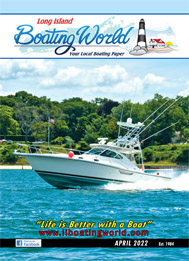
Not too long ago, a friend of mine fell overboard – while boarding a boat at the dock! Sound crazy? Not really – the “victim” wasn’t wearing proper shoes… he stepped on the gunwales and not into the boat… and the wake of a passing boat (which shouldn’t have been making a wake!) rocked the vessel strongly. In other words, things just go wrong at all the wrong times. Are you ready to deal with it? This column is about that.
Maaaan Ooooverboard!
As a case in point, when I take young boaters out for seamanship exercises, I start the man-over-board drills with an example. I bring the boat up to 20 knots and ask one of the youngsters to throw a fender over board – and then count to 10 before yelling “man overboard!” During those ten seconds, two things happen. The fender disappears behind the boat, well over a full football field behind, and the faces of the youngsters turn white and their jaws drop.
Don’t Fall Overboard!
Clearly, the best defense is not falling overboard. That means:
- No “bow riding”, i.e., sitting up on the bow with your feet dangling over the side (btw, violation of Federal regulations – no limbs outside the boat while underway). Assuming the prop misses you as the boat whizzes over you, you could very likely be rendered unconscious by the boat’s passing over you. And, again, that is assuming the propeller misses you.
- No sitting on the gunwales – the edge of the boat – even if you are holding on tight. The skipper takes a wake too hard and you are airborne. If you land in the boat, it is a small miracle. If you were sitting on the transom, unless the boat was in reverse, physics demands that you end up in the water, if you are lucky enough that the boat is going fast enough for you to land behind the propeller. You could be unlucky enough to land on the prop instead of in the water. A variation of sitting on the gunwales is holding the taff rail (railing around the stern of the boat) and jumping up and down with the swells as the boat passes over them. This is swell fun until the boat gets sluiced to one side or the other by those same swells pushing the bow around. Instead of coming down inside the stern of the boat, which a moment ago was just below you, you come down in the water.
- The failure to use the “3 point system” while working the boat can get even the most seasoned mariner. Always have 3 parts of your body in contact with the boat at all times, i.e., 2 hands, 1 foot; 2 feet, 1 hand. Try toppling over a 3-legged stool and you can see how much more stable this is than a 2-point system.
You Have Fallen Overboard!
You need to do two things. First, attract as much attention as possible as fast as you can. I never go on a boat without a knife, flash light and whistle on my person. The light and the whistle are to attract attention. The knife is to cut me away from the line I am tangled in that is dragging me below the water. Second, if the boat continues to steam away, start saving yourself – and that starts with conserving energy and heat. Eventually, someone will start to look for you. Don’t panic and waste life-sustaining energy. Assume the HELP position or at least float with your arms across your chest and your legs crossed. (See “Surviving Hypothermia!” in the months ahead.) If you slip below the water, don’t thrash and waste energy. Lie there for a few seconds and then dog paddle up. Get back in the prone position and start over. If the water isn’t too cold, you can do this for hours.
Someone Has Falled Off The Boat!
Train your crew in the following:
- The first person who sees someone fall overboard does two things simultaneously. First, shouts at the top of his lungs “man overboard” and, second, never takes his eyes off the person in the water and points at him constantly. I tell my crew, “Even if you have to watch him drown in front of you, never take your eyes off him.” Why? If you lose sight of him, we may never see him again. It is unbelievably difficult to find a head sticking up out of the water. This is why the USCG often sends helicopters first to look for people in the water.
- Someone else throws a cushion, fender, life-jacket – anything and everything – towards the victim to give him or her something to swim towards and hold onto.
- The boat driver brings the boat to neutral. The skipper then determines what side the victim is on and turns the boat to that side as the victim. It keeps the victim inside the turning radius of the boat – and keeps the propeller moving away from the person in the water.
- Call the USCG and tell the watch stander you have a man overboard! Your crewmate may be injured, have swallowed a lungful of water or be having a medical emergency (how about a heart attack?) Get the “rescue starts now” clock started ASAP!
- Once you get alongside the victim, turn off the engine. Those props are potentially dangerous. Stop the engine entirely – especially if you are getting him back aboard via a swim platform.
Try the 10-second exercise one day with your crew. And watch their faces as the fender disappears astern…
BTW, if you are interested in being part of USCG Forces, email me at JoinUSCGAux@aol.com or go direct to the D1SR Human Resources department, who are in charge of new members matters, at DSO-HR and we will help you “get in this thing
